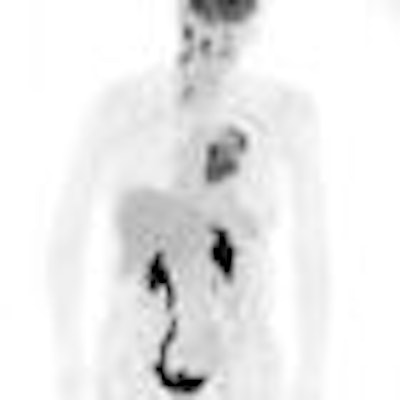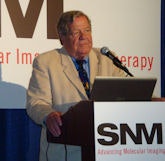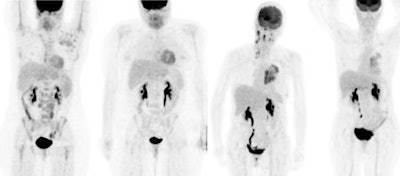
TORONTO - Dr. Henry Wagner's Image of the Year award is always a highlight of the annual SNM conference, but Monday was probably the first time he's given the presentation to a packed press room and a bank of TV cameras.
What accounts for the news media's newfound interest in nuclear medicine? The ongoing molybdenum-99 (Mo-99) crisis and the conference's fortuitous siting in Canada this year created a perfect storm of public relations exposure for a discipline that sometimes has been described as the underappreciated stepchild of medical imaging.
 |
|
Dr. Henry Wagner presents the Image of the Year award at SNM 2009. |
The SNM also organized a consortium of healthcare practitioners and researchers to advocate for a long-term solution to the Mo-99 supply issue, a move that included the appointment of past SNM President Dr. Alexander McEwan as a special advisor to the Canadian government.
Moly crisis update
The fast-moving moly crisis has been producing a new story every day during SNM week. The drama was even heightened by a vote of no confidence in the Canadian government expected to take place later in the week.
Though it's highly unlikely that the moly crisis is having any influence on the vote, Canadian Prime Minister Stephen Harper didn't win any friends in nuclear medicine when he said on May 28 that it was his intention to get the Canadian government out of the business of isotope production by 2016. Many nuclear medicine advocates were also smarting from the Canadian government's decision in 2008 to halt the completion of the Maple reactors, which were supposed to replace the aging National Research Universal (NRU) reactor currently causing problems at Chalk River.
At today's press conference, SNM officials said that, while they felt they had been adequately informed of the current crisis, they were unsure of what's involved in getting the NRU reactor back online, and whether AECL's estimate of three months for the repairs to take place would be accurate.
Indeed, incoming SNM President Dr. Michael Graham, Ph.D., of the University of Iowa in Iowa City said that the Canadian government's abrupt decision to cancel the Maple project had delayed the development of alternative supplies. Until the 2008 decision, many industry observers felt that there was no need to proceed with new reactors because the Maple reactors would serve as both a primary and backup supply.
In fact, the U.S. never moved forward with a plan to produce medical isotopes from a reactor at Sandia National Laboratories in Albuquerque, NM, because it assumed that it would be unnecessary when the Maple reactors came online.
"There were assurances 10 to 12 years ago, with the Maples coming online, that we didn't need in the U.S. to invest [in isotopes] anymore, so that project ceased," Graham said.
Nuclear medicine is now facing severe technetium shortages, as the NRU reactor supplied 50% of the Mo-99 used in the U.S., which conducts 16 million technetium-based procedures each year. What's even worse is that another reactor at Petten, Netherlands, is scheduled to be shut down for maintenance for an extended period in 2010. Together, the Chalk River and Petten reactors account for 70% of the world's molybdenum.
There is some hope in new sources for radioisotopes, SNM officials said. The Australian Nuclear Science and Technology Organization (ANSTO) recently brought its Open Pool Australian Light-water (OPAL) reactor online, and that facility will produce medical isotopes. Other options are University of British Columbia's TRIUMF reactor and the University of Missouri Research Reactor (MURR).
One other possibility is that work on the Maple reactors could be restarted. The facilities have been completed, but the reactors are not operating within specifications, and the Canadian government abandoned the project rather than invest the funds needed to bring them online.
But the Canadian government no longer appears to have the stomach to be in the nuclear reactor business, and it will take years for any of the other sites to begin producing the level of Mo-99 produced by the NRU facility, due to the need to get government approvals and to build the required processing facilities, Graham said.
In the meantime, nuclear medicine practitioners struggle along as best they can. Ironically, the current crisis may do more to drive a long-term solution to the molybdenum problem than if the aging Chalk River facility had continued to limp along.
"If Chalk River continued to produce, there wouldn't be nearly as many people in this room, and we wouldn't have this crisis," Graham said.
Image of the Year
The molybdenum crisis gave Wagner an expanded audience that went beyond the usual circle of industry trade press to highlight his Image of the Year award, and make the argument for nuclear medicine's utility as both a diagnostic and therapeutic tool. Reporters from the Canadian Broadcasting Corporation, the CTV television network, the Globe and Mail newspaper, and other Canadian news outlets probably learned more about nuclear medicine than they had bargained for.
For this year's award, Wagner chose a pair of images that demonstrate the use of radiotherapeutic payloads attached to chemotherapy drugs that illustrate the evolving discipline of radioimmunotherapy. The images came from a study performed at Stanford University in Stanford, CA, that treated non-Hodgkin's lymphoma patients with two types of radioimmunotherapy agents, one with an iodine-131 payload attached to the tositumomab (Bexxar) chemotherapy agent, and another that used yttrium-90 attached to ibritumomab tiuxetan (Zevalin).
 |
| These images demonstrate the use of yttrium-90-labeled ibritumomab tiuxetan (Zevalin) and iodine-131-labeled tositumomab (Bexxar) in a pair of non-Hodgkin's lymphoma patients. Two images at far left are before and after Zevalin-based radioimmunotherapy; images at right are before and after Bexxar-based radioimmunotherapy. Images courtesy of SNM. |
The Image of the Year award is actually going to two studies that show PET exams conducted on two patients, neither of whom demonstrated any metabolically active non-Hodgkin's lymphoma three months after treatment with the radioimmunotherapy agents, Wagner said. The images came from a larger study of 71 patients, 35 of whom received radiolabeled Bexxar and 36 of whom received radiolabeled Zevalin.
Of the Bexxar group, 24 of 35 patients responded to the treatment, while 28 of 36 Zevalin patients responded to that therapy. Between the two groups, 27 showed complete response to the drug; however, radioimmunotherapy wasn't effective in 19 of the 71 patients.
By Brian Casey
AuntMinnie.com staff writer
June 15, 2009
Related Reading
SNM poll: Isotope shortage affecting users, procedures, June 15, 2009
Canadian health minister meets SNM execs, June 15, 2009
Facing Mo-99 shortage, nuclear medicine economizes, June 11, 2009
Canada medical reactor shutdown may be extended, June 5, 2009
AECL reactor down 'at least three months,' May 29, 2009
Copyright © 2009 AuntMinnie.com




















